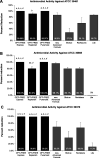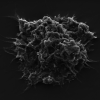Differential Antimicrobial Efficacy of Multipurpose Solutions against Acanthamoeba Trophozoites
- PMID: 34686635
- PMCID: PMC8677607
- DOI: 10.1097/OPX.0000000000001819
Differential Antimicrobial Efficacy of Multipurpose Solutions against Acanthamoeba Trophozoites
Abstract
Significance: This investigation examines the effectiveness of several common contact lens solutions in the disinfection of Acanthamoeba, which causes a serious eye infection most often resulting from dysfunctional or improper use of contact lens products.
Purpose: Acanthamoeba keratitis is an eye infection caused by a free-living amoeba, which can lead to extensive corneal damage and frequently blindness. Acanthamoeba keratitis is linked with contact lens use combined with noncompliance with contact lens care cleaning regimens. The patient's choice and use of multipurpose solutions (MPSs) continue to be a risk factor for Acanthamoeba keratitis. Thus, it is critical that the Acanthamoeba disinfection efficacy of the popular MPSs be determined. Here we compare the efficacy of seven major MPSs on the global market.
Methods: Using standard methods of Acanthamoeba disinfection and quantification, Acanthamoeba ATCC 30461, 30868, 50370, and 50676 trophozoites were inoculated into each MPS and held for the manufacturer's recommended disinfection time. Acanthamoeba recovery plates were incubated for 14 days, after which positive wells were identified and cell concentrations determined using the 50% endpoint method.
Results: Members of the OPTI-FREE products (Express, Replenish, and Puremoist [Alcon, Fort Worth, TX]) demonstrated significantly higher percentages of antimicrobial activity compared with the renu Advanced Formula (Bausch + Lomb, Rochester, NY), Biotrue (Bausch + Lomb), Acuvue RevitaLens (Johnson & Johnson, Santa Ana, CA), and Lite products (Cooper Vision, Scottsville, NY) for four of the trophozoite strains tested.
Conclusions: Many of the popular MPS biocides maintain little or no antimicrobial activity against Acanthamoeba trophozoites, and the number of biocides in an MPS does not necessarily indicate its antimicrobial activity.
Copyright © 2021 The Author(s). Published by Wolters Kluwer Health, Inc. on behalf of the American Academy of Optometry.
Conflict of interest statement
Conflict of Interest Disclosure: All authors are employees of Alcon Research LLC. The authors have full access and control of the data reported in the study and take full responsibility for their presentation in this article. Alcon Research LLC funded the study.
Figures






References
-
- Carnt N Hoffman JJ Verma S, et al. . Acanthamoeba Keratitis: Confirmation of the UK Outbreak and a Prospective Case-Control Study Identifying Contributing Risk Factors. Br J Ophthalmol 2018;102:1621–8. - PubMed
-
- Datta A, Willcox MD, Stapleton F. In Vivo Efficacy of Silver-impregnated Barrel Contact Lens Storage Cases. Cont Lens Anterior Eye 2021;44:101357. - PubMed
Publication types
MeSH terms
Substances
LinkOut - more resources
Full Text Sources

